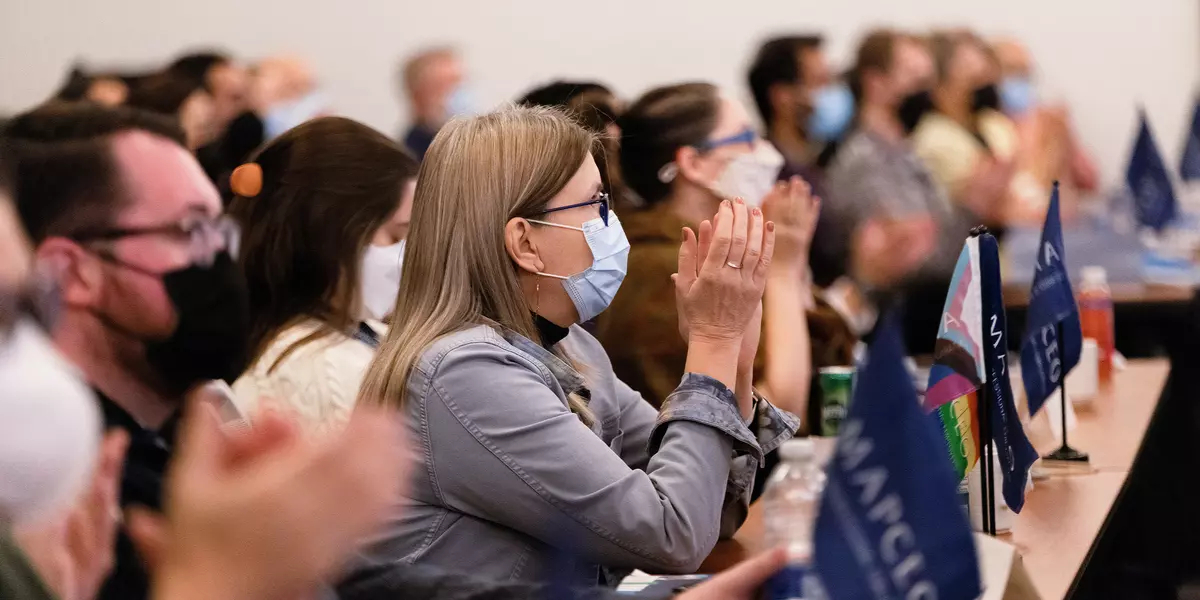As a grassroots union, AMAPCEO is powered by the participation of our members. We encourage you to use your voice, insights, and skills to strengthen your union and help advocate for better working conditions for all.
There are four different types of volunteer roles at AMAPCEO:
Caucus Roles – building community and cultivating recognition, support, and understanding for diverse constituency groups to help AMAPCEO become a more equitable union.
Membership Engagement Roles – keeping your colleagues informed and engaged on AMAPCEO issues and activities, particularly during critical periods such as bargaining.
Workplace Roles – working with AMAPCEO members to make sure their rights are protected and to secure a safe, healthy, and fair workplace environment for all.
Governance Roles – being involved directly in the direction of AMAPCEO and representing members in key decision-making.

Equity Caucuses
The equity caucus model is designed to create a space for AMAPCEO members in specific demographic and cultural groups to build community and provide alternative opportunities for members (particularly those in under-represented groups) to engage with and participate in their union.
There are currently nine equity caucuses:
- Asian Caucus
- Arab Caucus
- Black Caucus
- Disability Caucus
- Francophone Caucus
- Indigenous Circle
- Latinx Caucus
- Pride Caucus
- Women's Caucus
The caucuses are represented on the Board’s Equity Committee, the Activists and Leaders Forum, and at the Annual Delegates’ Conference.
Learn more about the Equity Caucuses, including how to join »

Member Engagers
Member Engagers work with local leaders, such as members of the District Executive, to:
- contact and welcome new members;
- recruit members for activist roles;
- assist in mobilizing members to engage in union activities and surveys; and
- help organize and publicize AMAPCEO-supported community and social events.
This role is ideal if you want to be involved in your union, but not in an elected role or as a representative engaging with management, or if you are interested in doing member-to-member outreach and engagement. You may even already be engaged in coordinating external campaigns or social activities in your workplace.
Apply here to become a Member Engager volunteer »
(sign in required)
Materials Leads
Materials Leads pass on information and keep their colleagues in the loop about union news by:
- receiving the Bulletin Board mail-out from the AMAPCEO office;
- posting the materials on the bulletin board;
- distributing additional materials sent out (flyers/posters/etc.); and
- contacting the office to request additional copies of posters/materials.
This role is ideal for you if you want to be involved in your union but have limited time or prefer to play a behind the scenes role. And if you enjoy craft and design, even better!
Apply here to become a Materials Lead volunteer »
(sign in required)

Workplace Representatives
A Workplace Representative is a colleague who acts as a front-line contact for fellow AMAPCEO members seeking information and advice about their rights as employees, their Collective Agreement, and how to resolve workplace issues. Workplace Representatives are trained by AMAPCEO and work directly with the union’s staff Workplace Advisors and Dispute Resolution Officers.
Fixed-Term Eligibility for Workplace Representatives - a Fixed-Term Employee (FXT) can be appointed as a Workplace Representative, as long they have been in their current AMAPCEO FXT position for at least 6 months, and their current FXT contract is for at least 18 months or more.
Apply here to become a Workplace Representative »
(sign in required)
Health and Safety Representatives
Health and Safety Representatives are appointed by AMAPCEO under the provisions of the Occupational Health and Safety Act to ensure their workplaces are safe working environments.
If there are at least 20 employees in a workplace, these representatives sit on joint Health and Safety Committees with management and other union representatives and can make recommendations to management to improve safety in the workplace.
Fixed-Term Eligibility for Health and Safety Representatives - a Fixed-Term Employee (FXT) can be appointed as a Health and Safety Representative, if they have 12 or more months remaining on their contract.
Apply here to become a Health and Safety Representative »
(sign in required)
Employee Relations Committee Representatives
Each bargaining unit represented by AMAPCEO—in the case of the Ontario Public Service, each ministry—has an Employee Relations Committee (ERC), a joint body to which AMAPCEO and management appoint an equal number of representatives. They meet regularly to discuss workplace issues.
ERC meetings address specific responsibilities outlined in the Collective Agreement and provide an opportunity to resolve local workplace issues through informal discussion. An AMAPCEO staff resource person also attends ERC meetings alongside ERC Representatives.
AMAPCEO ERC Representatives must first qualify as Workplace Representatives.
Apply here to become a Employee Relations Committee Representatives »
(sign in required)

Governance Roles
To learn more about AMAPCEO’s Governance Roles, we recommend you first read about our Governance and Structure.
District Delegates
Delegates are elected directly by signed AMAPCEO members in each District. They have two important roles: they serve with their District Director on the District Executive Committee, which meets at least four times each year, and they attend as voting members of the Annual Delegates’ Conference.
The District Executive Committee is responsible for promoting member engagement and volunteer recruitment, and organizing membership events in the District.
The Annual Delegates’ Conference is responsible for:
- electing the four Executive Officers and a number of central committees;
- approving the annual operating budget;
- appointing external auditors and reviewing audited financial statements;
- adopting constitutional amendments; and
- setting overall priorities for the union.
Each District also selects Delegates to sit on the AMAPCEO Activists and Leaders Forum.
Board of Directors
Under AMAPCEO’s Constitution, the internal affairs of our union are managed by an elected 15-member Board of Directors. The Board consists of 11 District Directors and four Executive Officers: President, Vice-President, Secretary, and Treasurer.
District Directors’ responsibilities include:
- preparing policies for consideration by the Annual Delegates’ Conference;
- implementing the decisions of governance bodies;
- spending funds in accordance with the annual budget;
- interpreting the AMAPCEO Constitution;
- managing the bargaining process; and
- chairing the District Executive Committee in their District.
Learn more about the roles and responsibilities of Board Directors »
Learn more about how to run for a District Director or Executive Officer position »
Committees
Both the Board of Directors and the Annual Delegates’ Conference appoint or elect members to several central committees. Committee members typically serve a two-year term.
The Annual Delegates’ Conference has four standing committees: Activist Recognition; Audit; Elections and Credentials; and Resolutions.
The Board of Directors currently has three standing committees: Equity; Health, Safety and Wellness; and Workplace Relations.
